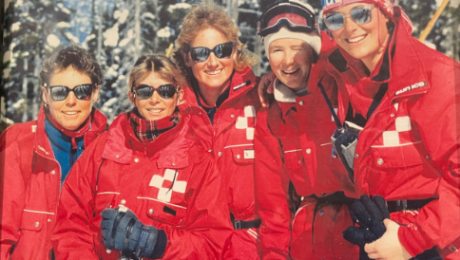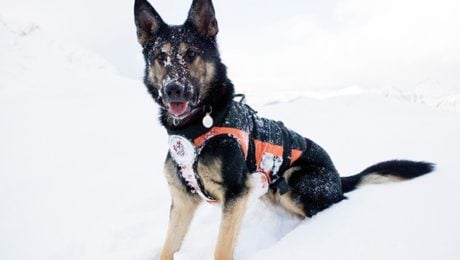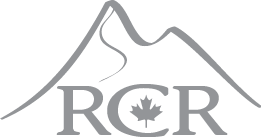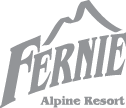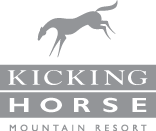Fernie Ski Patrol’s Mentorship Legacy and Future
How does mentorship play a role in professional development on the mountain?
Fernie Alpine Resort is home to some of the best skiing and snowboarding in Western Canada. With the elite terrain and large snowfall comes huge responsibilities for ski patrollers. Besides getting to ski powder while the rest of us wait with nervous anticipation for the lifts to open or the rope to drop—they are carrying the mental (and physical!) weight of keeping the mountain safe for everyone and often dealing with multiple incidents on top of heavy snowfall and tricky avalanche conditions. It requires an incredible amount of teamwork, compassion, strength, and mental fortitude.
But how do you succeed as a professional ski patroller, and what challenges are there for women in these roles? Data shows that only 23% of pro patrollers are women today.
I sat down with a few Fernie Alpine Resort legends to learn more about how mentorship has factored into the success of past, present, and future female professional ski patrollers.
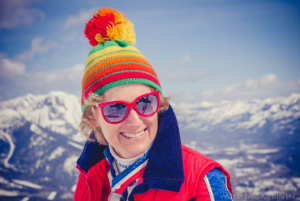 Sue Boyd is a local Fernie legend. She started her career as a professional ski patroller in Blackcomb back in 1985, where she was one of six women on the roster. When Sue was hired at Fernie Snow Valley in 1990, she was the only female professional ski patroller until 1996. (Sue notes that she was not the first female professional ski patroller—there was another woman there in the early 80s). One of the claims to fame that Sue does have: she was the first female Ski Patrol Leader at Fernie Alpine Resort from 2002 to 2005.
Sue Boyd is a local Fernie legend. She started her career as a professional ski patroller in Blackcomb back in 1985, where she was one of six women on the roster. When Sue was hired at Fernie Snow Valley in 1990, she was the only female professional ski patroller until 1996. (Sue notes that she was not the first female professional ski patroller—there was another woman there in the early 80s). One of the claims to fame that Sue does have: she was the first female Ski Patrol Leader at Fernie Alpine Resort from 2002 to 2005.
Sue has a long list of achievements that go well beyond her role as a Patrol Leader in Fernie. She was a Canadian Freestyle Ski Team member and competed in moguls, aerials, and ski ballet at the World Cup Level. As a CARDA dog handler, she has trained and certified three avalanche rescue dogs throughout her career. She’s taught Non-stop ski patrol training courses and AST courses. She worked at Island Lake Lodge for eight years as a tail guide and snow safety and explosives trainer. And if that isn’t cool enough, she also has led backcountry horse trips in the mountains around Canada.
Sue credits her success in her career on snow to being a good listener, someone who pays close attention and asks meaningful questions. She also says having something in common with the person you are learning from helps.
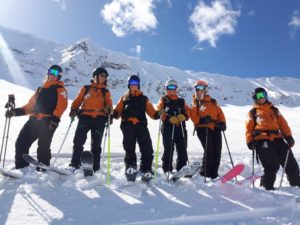 When I asked Sue if she’s ever had the chance to mentor someone else, she highlighted that her success and experiences in the mountains mirror many life lessons we tend to learn over time. Meaning? It’s all about just getting along with folks. “I didn’t think of it as ‘I’m the mentor, you’re the mentee,’ it just happened. If someone wanted to learn from me, and I felt accepted as being able to teach them, and we got on well, I would share my knowledge and experience. Personalities are a big part of it. Sometimes it works, sometimes it doesn’t. There has to be mutual respect at both ends.”
When I asked Sue if she’s ever had the chance to mentor someone else, she highlighted that her success and experiences in the mountains mirror many life lessons we tend to learn over time. Meaning? It’s all about just getting along with folks. “I didn’t think of it as ‘I’m the mentor, you’re the mentee,’ it just happened. If someone wanted to learn from me, and I felt accepted as being able to teach them, and we got on well, I would share my knowledge and experience. Personalities are a big part of it. Sometimes it works, sometimes it doesn’t. There has to be mutual respect at both ends.”
I asked Fernie Alpine Resort’s current ski patrol director, Tyler Steen, about Sue: “Sue was definitely a mentor to me. [She] has a level of professionalism that no one can mimic.” I asked for specifics with regard to how he defines professionalism in the ski patrol sense, and Tyler said, “Sue treated everyone the same way: She always looked at the uniform and not the person in the uniform. Even when she wasn’t actively mentoring, it would be visual. Sue always acted with the skill, talent and confidence everyone admired. I took every opportunity to observe and learn as she performed the job efficiently and effectively. She was a true professional ski patroller that we were lucky to have.”
This underscores the fact that there needs to be mutual respect for a mentor-mentee relationship to blossom. Tyler added, “this idea of a formal mentorship program for ski patrollers isn’t as straightforward as you would think. You can’t pair a Level 4 patroller with a Level 1 [patroller] just because it makes sense on paper. The person who’s learning needs to be willing to accept the knowledge being shared.”
Zooming forward from Sue’s reign on FAR patrol, I also had the chance to catch up with Olivia Johnson, a Senior First Aid Officer on professional ski patrol with Fernie.
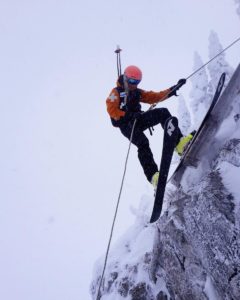 Olivia, affectionately known as “OJ”, has been on Fernie’s professional patrol squad for six seasons. “When I first started on patrol, there was still a ‘macho culture’ among the women on patrol. I wanted to do everything I could to break down that thinking. I always felt like I had to prove that I was better than the other women I worked with, or that I was a better skier, or better at this, or better at that. Thankfully there has been a big culture shift in the last six years. I work with some fantastic women who don’t need to compete with other women because of their gender. I also work with some fantastic men that fully understand that women are just as capable (if not more capable) than them and let us feel heard. The barriers are breaking down, and it feels great.”
Olivia, affectionately known as “OJ”, has been on Fernie’s professional patrol squad for six seasons. “When I first started on patrol, there was still a ‘macho culture’ among the women on patrol. I wanted to do everything I could to break down that thinking. I always felt like I had to prove that I was better than the other women I worked with, or that I was a better skier, or better at this, or better at that. Thankfully there has been a big culture shift in the last six years. I work with some fantastic women who don’t need to compete with other women because of their gender. I also work with some fantastic men that fully understand that women are just as capable (if not more capable) than them and let us feel heard. The barriers are breaking down, and it feels great.”
Tyler says this inclusive attitude is something he and the Assistant Patrol Director, Megan Kelly, actively cultivate. “We have created a mentorship culture that encourages people to actively seek out that mentorship from whoever and wherever they can get that from. If we’re doing it right, anyone can participate. Our main job is to give the individual the opportunity to succeed, and it’s up to them to take advantage of it.”
Sue might have been the first female lead patroller at Fernie Alpine Resort, but it’s clear that the team invests in gender diversity through its “hands-off’ mentorship approach that encourages the ‘whole’ person to show up for the job and be willing to work hard on a team with a positive attitude and curiosity for learning. It’s exciting for Fernie to have more women in leadership positions and cultivate an atmosphere that elevates that as a norm and not an exception.
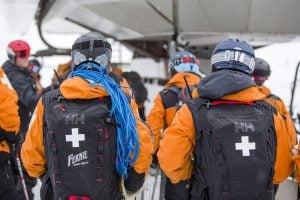 This weekend Fernie Ski Patrol will be hosting a recruitment day for interested future patrollers to learn more about what the job entails and what it’s like to work on mountain safety, first aid, and avalanche safety as a professional ski patroller. Tyler Steen says there are already nine women signed up, and of the 44 current professional ski patrollers at Fernie Alpine Resort, 14 identify as female.
This weekend Fernie Ski Patrol will be hosting a recruitment day for interested future patrollers to learn more about what the job entails and what it’s like to work on mountain safety, first aid, and avalanche safety as a professional ski patroller. Tyler Steen says there are already nine women signed up, and of the 44 current professional ski patrollers at Fernie Alpine Resort, 14 identify as female.
With this in mind, being a good, professional ski patroller is not about being the raddest skier on the mountain. Some of the challenges we face today with regard to inclusion in this career can be solved by limiting our biases and being open and willing to learn, ask questions, and treat each other with respect and as equals.
Have you ever seen a dog riding a chairlift?
Have you ever seen a dog riding a chairlift? How about a dog skiing next to its owner? Or even crazier, a dog being long-lined under a helicopter? These are just a few of the skills that make avalanche dogs… Super canines!
Meet Mogul, a four-year-old German Shepherd who adores his ball and will do anything for fresh veggies. When Mogul isn’t falling asleep with a ball in his mouth or receiving never-ending attention, he also works as a Canadian Avalanche Rescue Dog AND a Search and Rescue Dog. This means Mogul has a job all year round, making sure his handler, as well as anyone venturing into the backcountry, can play safe. So what exactly does it take to become an avalanche dog? To answer that question we caught up with Megan Kelly, Assistant Ski Patrol Director for us here at FAR, and companion to the amazing, Mogul.
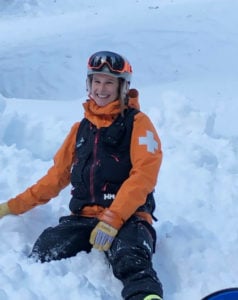
Megan Kelly, Assistant Ski Patrol Director & Mogul’s handler
Preparation for the Canadian Avalanche Rescue Dog Association (CARDA) certification begins when a puppy is just six months old. It starts with simple obedience training such as following commands, playing tug-of-war, and getting the dog to chase objects or people. It gradually progresses to the handler hiding and having the dog come find them. Eventually, they progress to open snow caves, where someone can hide, awaiting discovery. The snow caves go from being open to having closed off walls. The last step in the progression is using articles, usually, pieces of wool fabric saturated with human scent, buried under the snow. The dog eventually learns that in a real avalanche situation it is very unlikely they’ll have clues, so they need to rely on the scent of a human rising from under the snow to help find them. Finally, the dog is able to be given a command, like “search”, and will have the control to do their work and search for a missing person. The final test to complete certification requires the dog to search for 40 minutes, looking for two articles buried 75 centimetres under the snow to mimic a live person. CARDA certification takes a year and a half to complete and requires dogs to be tested every year in order to keep up their certification. Handlers are also tested every second year to make sure their skills are still up to date.
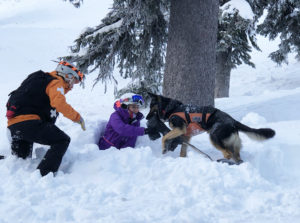
Mogul after completing a demonstration rescue.
So what can an avalanche dog achieve that aids in a successful rescue? Simply put, it would take a search and rescue team up to four hours or more to search one hectare of terrain. It takes an avalanche dog just thirty minutes to achieve the same results. With avalanche dogs being so quick, agile, and possessing a highly sensitive nose, they use their training to identify human scents and track it right to the source.
Fun fact time! Did you know that Fernie has the privilege of the first live rescue done by an avalanche dog in Canada? That’s right! In the early 2000s, Robin Siggers and his avalanche pup Keno recovered someone who had been caught in an avalanche in the backcountry without a transceiver. It was this circumstance as well as inspiration from other handlers in town that caught Megan’s attention. In describing why she decided to become an avalanche dog handler Megan said, “I was inspired by that working relationship, you know the fact that you can bring the dog to work. There’s also a chance you can really make a difference in someone’s life or you can save a life, I just wanted to contribute to that, and it’s a good way to volunteer.” Megan and Mogul are part of the 40 other volunteer search and rescue members in the valley and are on call 24 hours a day. There are two other full-time avalanche dog and handler teams, as well as a few part-time teams, who not only serve Fernie and area but can also be called provincially to aid in rescues.
But don’t think it’s all work and no play! According to Megan, Mogul is a best friend who receives all the best treatment. “Mogul really loves just being at the top of the lift at Bear top and just hanging out and saying hi to everyone. When he retires he’d like to be a Public Relations dog.” When the working vest is off, Mogul loves to bask in the attention of the public, but when the vest is on he’s much like a celebrity who has learned to ignore the praise of their adoring fans. No paparazzi, please!
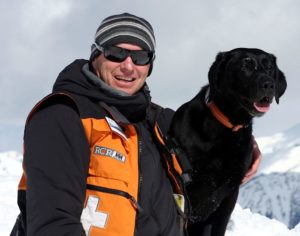
Steve & Neko Photo Dave Watts
Steve Morrison, who is a member of the ski patrol team at FAR and handler to avalanche dog Neko, cautions the general public to be aware that avalanche dogs are working dogs. “…We want people to be friendly, but just at the right time. After I take his vest off is a good time, because otherwise, that’s the cue that the dog is working. I’m usually fine with people approaching the dog, as long as they ask me and maybe remove their skis or snowboard first…”
Speaking of meeting our super avalanche dogs, we are happy to be offering two demos to show off their stuff on February 23rd! Avalanche Awareness Day is coming your way, and it should come as no surprise that we’ve got plenty of fun and educational activities planned in the plaza and on the mountain. From 11 am to 2 pm we’ll have an Avalanche Awareness Information tent set up in the plaza. Don’t miss your opportunity to meet and watch our avalanche dogs in action, happening at 11 am AND 2 pm at the base of the Deer Chair. And finally, join us for an après fundraising auction in the Griz Bar, the proceeds of which go to Avalanche Canada to support their educational initiatives.
So why should you take the time to become more avalanche aware? According to Megan, the backcountry invites you to learn and discover. “The backcountry has given me so much in my life. I’ve learnt so much about myself, I’ve connected with nature, I’ve developed these cool skills by going into avalanche terrain in the winter. But I’ve done that by being avalanche aware and keeping myself safe, having the right gear and knowing how to use it. That’s opened up this whole world for me, which is why I encourage people to go ahead and become avalanche aware, so you don’t have to avoid that terrain if you don’t want to. You can engage in it and learn something about yourself.”
So whether you are shredding it up with us at Fernie Alpine Resort, or having an adventure in the backcountry, be aware and most importantly… Stay safe and play safe!
For more information on CARDA please visit here.
You can also watch the following informative video, and see a dog flying from a helicopter, by clicking here.
More information on Avalanche Awareness Day here.
To see Mogul in action click here.
Feature photo of Mogul by Abby Cooper





